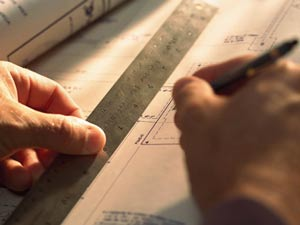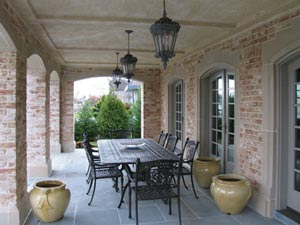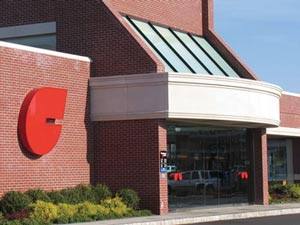 Below is an overview of the Cast Stone manufacturing process and reviews designing it with the Project Budget in mind.
Below is an overview of the Cast Stone manufacturing process and reviews designing it with the Project Budget in mind.
Please click on the highlighted links to obtain further information on a particular topic. In addition, our Related Links Page can direct you to organizations such as the Cast Stone Institute and the AIA where additional information is available.
Cast Stone is a highly refined architectural precast concrete building stone manufactured from a blend of Portland cement, coarse and fine aggregates and inorganic iron oxide pigments to achieve the desired color and appearance while maintaining durable physical properties which exceed most natural cut building stones.
Cast Stone is an excellent replacement for natural cut limestone, brownstone, sandstone, bluestone, granite, slate, marble and other natural building stones as well as terra-cotta.
Cast Stone is generally used as an architectural feature, trim, ornament or facing for buildings or other structures.
- Manufacturing Cast Stone
- Estimating and Value Engineering
- Field Measuring and Laser Scanning
- Cast Stone Detailing
- Engineering of Anchor System
- Pattern and Mold Shop
- Earth Moist / Vibrant Dry Tamp Cast Stone
- Steam Curing
- Inspection and Packaging
- Degrees of Customization
- Finishes
- Economy of Scale
Related Info: Basic Comparisons between Various Masonry Materials (#49)
Manufacturing Cast Stone
Manufacturing Cast Stone is generally regarded as the most labor-intensive of all concrete products’ manufacturing processes. There are several distinct disciplines inherent to Corinthian Cast Stone’s production sequence:
Estimating and Value Engineering:
 During this phase the project is discussed with the Client and ideas are reviewed that will enhance the project aesthetically as well as reducing the budget required, while conforming to the Architects’ design intent. Items thoroughly examined are repetition (the economy of scale), profile design, maximum dimensional considerations and anchoring details. Estimating and takeoffs are done from Architectural Drawings ( we prefer pdf files) or if the job is simple, only faxed sketches may be required.
During this phase the project is discussed with the Client and ideas are reviewed that will enhance the project aesthetically as well as reducing the budget required, while conforming to the Architects’ design intent. Items thoroughly examined are repetition (the economy of scale), profile design, maximum dimensional considerations and anchoring details. Estimating and takeoffs are done from Architectural Drawings ( we prefer pdf files) or if the job is simple, only faxed sketches may be required.
Field Measuring / 3d laser scanning – your insurance policy:
New construction requires the coordination of trades to prevent construction clashes and the ability to adapt to these conditions when they do occur.
Restoration, preservation and landmark projects require that buildings and architectural artifacts be documented before demolition to ensure that recreation of the original is exact.
Corinthian Cast Stone utilizes laser scan metrology technology to document existing conditions whether a building façade, a roof coping layout or an architectural artifact.
 Benefits of high definition laser scan field documentation:
Benefits of high definition laser scan field documentation:
- Speed – entire buildings or sites can be measured in 20% of the time it would take a traditional surveyor to collect less data. Because the scanners collect a 360 degree sphere of information, not only do we measure our trade but we capture the adjacent trades too. By having this information we can prevent clashes in the field which would result in costly rework time.
- Accuracy – Using the best technology on the market we are able to measure to within millimeters…every time. We don’t go back because we missed a dimension or forgot to measure something.
- No penetration of the building envelope- You do not have to surgically remove stone, temporarily water proof the penetration and temporarily shore the area for months while waiting for the new units to arrive. Our laser scanners and certified technicians are NYC scaffold (suspended and pipe) ready. We will scan your stone, terracotta, wood, fiberglass or metal artifacts while in place and create 3D models of the units to be recreated for your approval.
Cast Stone Detailing (shop drawings):
Submittal drawings are equally important to the project-
Coupling existing conditions survey and the architect’s drawings we will create a submittal drawing set that explains in detail the entire project as it relates to our scope of engagement. We will offer suggestions that will help reduce cost or improve aesthesis while maintaining the Architect’s design intent.
The Cast Stone Detailing Department is where the Architects’ and Designers’ Visions turn into Production drawings.
Shop drawings are prepared showing:
- Details of the stone to be provided including: profiles, cross-sections, reinforcement, exposed faces, arrangement of joints, annotation of stone types and their layout and location on the structure.
- Comprehensive dimensions are shown on all shop drawings. Units are identified with a piece marking system. Finished surfaces are shown, where exposed to view. Additionally, when required to do so, or when it will simply benefit the project, our drafting department will 3-D render a particular stone or an entire façade.
Before beginning a new job, the detailer verifies that the contract drawing set is the most recent available and secure the Full Set of Construction Documents (predicated by the scope of work, all elevations. sections, details, structural drawings and surveys are essential, less Mechanicals, Electrical and Plumbing documents).
Moreover the construction schedule or the sequence of how the building is to be built is essential, as the shop drawings are prepared in that sequence.
Anchor & Fastener design / Professional Engineering:
Our engineering services comprise the schematic design of anchors and anchor
assemblies, including the selection of anchor and fastening materials and combinations
of materials for optimum results. CCS uses current / identified building codes to determine the forces (i.e. wind velocity, dead and live loads as well as seismic) that a structure must withstand, and engineers the anchors and fasteners accordingly.
Two packages are available
Basic design – this package is comprised of anchor fabrication tickets as well design calculations. The material selection, anchor design and fastener design will be calculated and stamped by a Professional Engineer in the State the project is located in.
Setting package – this package is comprised of anchor fabrication tickets, design calculations and location schematics for the setters use. The material selection, anchor design and fastener design will be calculated and stamped by a Professional Engineer in the State the project is located in.
Each anchor type and typical stone assembly will be detailed and all anchors will be shown in the setting drawings (if CCS is not supplying the cast or natural stone, you will need to supply CAD file for us to coordinate documents).
Pattern and Mould Shop:
Most manufacturers will tell you that the “heart of the plant” is the “Pattern and Mold Shop”; Corinthian Cast Stone Inc., is proud to have one of the most advanced facilities in the industry.
Technology has changed the nature of our work – no longer does the pattern and mold shop rely on using solely artisans and archaic mold making methods of “pulling plaster or similar materials over wood buildups” or making “field molds”.
Today our pattern and mold shop is filled with laser scanners and powerful 3d software to replicate architectural artifacts. The certified technicians design for and operate large 3 and 5 axis CNC routers that can carve any wood, plastic, composite or foam material in any shape and size you can dream of.
Patterns are a positive image; made from any material:
- The actual piece to be restored and or replicated ,
- An element that is hand or machine sculpted from original art by our client or our shop,
- Clients may provide a maquette( a small scale model ) to be 3D scanned, scaled and carved
- Please keep in mind that while Original Elements may be brought to the shop for restoration however, the better the condition the original is in the less it will cost to restore. Take advantage of our investment in technology – Our Certified Technicians will come to your site, scan the existing terracotta, limestone or other artifact and re-sculpt the unit digitally. This requires NO PENETRATION of the building envelope until the new architectural elements arrive on site for installation.
Molds are the negative of the architectural element. This is what the casting material is put in.
- According the size of the architectural element being replicated or project and the amount of detail, molds are made of different materials.
- Molds can be made from Wood, Composites, Fiberglass, Rubber, Metals or any combination of materials.
- High quantity or fast track jobs generally have molds carved and assembled of wood, plastics and fiberglass. Elements with undercuts may have molds built of rubber.
- In either case, the Project Team responsible for the assignment determines the best material for the job.
Corinthian Cast Stone’s Pattern and Mold Shop fabricates our own projects but also supplies some of the industry’s leading cast stone, precast, fiberglass manufacturers and metal foundries, artists, scenery and special effects ( FX ) companies with patterns and molds and castings in a variety of materials.
Cast Stone fabricated using the VDT production system
 Corinthian Cast Stone Inc. manufactures using the “Earth Moist Vibrant Dry Tamp” (EMVDT) system. This requires a precisely proportioned mix design consisting of carefully graded and washed natural gravel and sand combined with crushed graded stone such as granite, marble, quartz, or limestone conforming with ASTM C 33.The mixtures are proportioned for maximum density and to produce the required color and finish, defined as:
Corinthian Cast Stone Inc. manufactures using the “Earth Moist Vibrant Dry Tamp” (EMVDT) system. This requires a precisely proportioned mix design consisting of carefully graded and washed natural gravel and sand combined with crushed graded stone such as granite, marble, quartz, or limestone conforming with ASTM C 33.The mixtures are proportioned for maximum density and to produce the required color and finish, defined as:
“All surfaces intended to be exposed to view shall have a fine-grained texture similar to natural stone, with no air voids in excess of 1/32 in (0.8 mm) and the density of such voids shall be less than 3 occurrences per any 1 in.² (25 mm2) and not obvious under direct daylight illumination at a 5 ft (1.5m) distance.”
Corinthian Cast Stone is pleased to boast about its fully computerized Batch Plant. Computers control each component of the mix design; aggregates and cements to water and admixtures each item is weighed and dosed automatically. The time, temperature and moisture content of each batch is monitored to ensure that each batch is the same – EVERY TIME.
Cast Stone fabricated using the EMVDT production system is made by vibratory ramming earth moist, zero-slump concrete against rigid formwork until it is densely compacted and ready for immediate removal from the form.; enabling as many as 100 pieces to be cast from a single mold in an eight-hour day thus it is ideally suited to fast-track construction projects due to its production capability. The EMVDT process guarantees total absence of bug holes and a fine grained finish which is almost impossible to distinguish from natural stone.
Steam Curing is an integral component to proper Cast Stone fabrication
Curing is an integral component to proper Cast Stone fabrication. Although the actual mix designs that Corinthian Cast Stone Inc. uses are proprietary, it is common knowledge that a rich cement/aggregate ratio is normally used in the fabrication of Cast Stone. The matrix achieves its strength through a process called hydration. With the addition of the correct amount of water, cement gels into a paste that binds the components of the mix design together to form hardened concrete.
The climate during the hardening of the concrete is of enormous importance for the quality of the hydration and the strength gain. The ambient temperature plays an important role in determining the speed of the hydration process. The warmer the air is, the warmer the concrete is and the quicker the concrete gains strength. The three most important elements in the curing chamber are: moisture, temperature and carbon dioxide. All three have a significant effect on the hydration process at elevated, though controlled levels. Properly cured Cast Stone (CSI 4720) will have a substantially higher compressive strength and a lower cold water absorption rate than natural limestone (CSI 4400) or precast concrete (CSI 3450). The EMVDT method, due to its low water/cement ratio typically yields higher compressive strengths than low-slump concrete.
Modern Steam Curing Technical Bulletin
Inspection and Packaging:
To ensure proper fit and to facilitate the setter’s job, the Cast Stone is inspected dimensionally using approved shop drawings. The Cast Stone Institute tolerances are applied to the required dimensions, if they are more stringent than the project specifications, or if no specifications are available. On a daily basis, the production runs are checked for color and finish against the approved sample, regardless of whether they are standard colors. All Corinthian Cast Stone units are permanently marked on an unexposed side of the stone, according to the approved shop drawings.
Corinthian Cast Stone will arrive at your jobsite on flatbed trucks; shrink wrapped on readily identifiable pallets that can be easily coordinated with the approved shop drawings.
Degrees of Customization:
 Cast Stone is often the defining element on the façade of the building. It serves to accent the other masonry as well as the architecture of the project. Corinthian Cast Stone strives to detail Cast Stone units that conform to the Architects Design Intent while gaining the economy of scale and the benefits derived thereof. Cast Stone is available in various degrees of customization.
Cast Stone is often the defining element on the façade of the building. It serves to accent the other masonry as well as the architecture of the project. Corinthian Cast Stone strives to detail Cast Stone units that conform to the Architects Design Intent while gaining the economy of scale and the benefits derived thereof. Cast Stone is available in various degrees of customization.
Finishes
Corinthian Cast Stone Inc. offers a variety of finishes that simulate natural cut building stone. While our standard finish is a fine grained texture similar to limestone, the Company has successfully completed projects with Bush Hammed , ADA nonslip compliant, Natural Cleft, and simulated Terra-Cotta Rake Line finishes. In short any finish that has been tooled or carved into natural cut building stones ( and many others that can’t) can be achieved by Corinthian Cast Stone Inc.
Economy of Scale
The cost per unit depends greatly on the design of the individual stone unit, the amount of repetition, the specified finish and the bid documents. On average, however, Cast Stone costs less than quarried (and then milled or carved) stone. There are several reasons. One is that Cast Stone is a molded product and once the mould is made, there is no additional tooling cost incurred, whereas each piece of cut stone must be carved individually. Another reason is speed; EMVDT Cast Stone is produced rapidly, depending upon the size and profile required, up to 100 pieces may be fabricated from one mould in one work shift.
